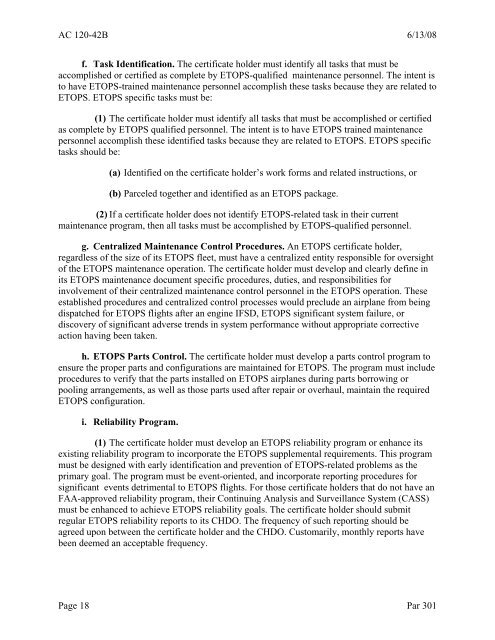AC 120-42B ETOPS and Polar Ops - Code7700
AC 120-42B ETOPS and Polar Ops - Code7700
AC 120-42B ETOPS and Polar Ops - Code7700
You also want an ePaper? Increase the reach of your titles
YUMPU automatically turns print PDFs into web optimized ePapers that Google loves.
<strong>AC</strong> <strong>120</strong>-<strong>42B</strong> 6/13/08f. Task Identification. The certificate holder must identify all tasks that must beaccomplished or certified as complete by <strong>ETOPS</strong>-qualified maintenance personnel. The intent isto have <strong>ETOPS</strong>-trained maintenance personnel accomplish these tasks because they are related to<strong>ETOPS</strong>. <strong>ETOPS</strong> specific tasks must be:(1) The certificate holder must identify all tasks that must be accomplished or certifiedas complete by <strong>ETOPS</strong> qualified personnel. The intent is to have <strong>ETOPS</strong> trained maintenancepersonnel accomplish these identified tasks because they are related to <strong>ETOPS</strong>. <strong>ETOPS</strong> specifictasks should be:(a) Identified on the certificate holder’s work forms <strong>and</strong> related instructions, or(b) Parceled together <strong>and</strong> identified as an <strong>ETOPS</strong> package.(2) If a certificate holder does not identify <strong>ETOPS</strong>-related task in their currentmaintenance program, then all tasks must be accomplished by <strong>ETOPS</strong>-qualified personnel.g. Centralized Maintenance Control Procedures. An <strong>ETOPS</strong> certificate holder,regardless of the size of its <strong>ETOPS</strong> fleet, must have a centralized entity responsible for oversightof the <strong>ETOPS</strong> maintenance operation. The certificate holder must develop <strong>and</strong> clearly define inits <strong>ETOPS</strong> maintenance document specific procedures, duties, <strong>and</strong> responsibilities forinvolvement of their centralized maintenance control personnel in the <strong>ETOPS</strong> operation. Theseestablished procedures <strong>and</strong> centralized control processes would preclude an airplane from beingdispatched for <strong>ETOPS</strong> flights after an engine IFSD, <strong>ETOPS</strong> significant system failure, ordiscovery of significant adverse trends in system performance without appropriate correctiveaction having been taken.h. <strong>ETOPS</strong> Parts Control. The certificate holder must develop a parts control program toensure the proper parts <strong>and</strong> configurations are maintained for <strong>ETOPS</strong>. The program must includeprocedures to verify that the parts installed on <strong>ETOPS</strong> airplanes during parts borrowing orpooling arrangements, as well as those parts used after repair or overhaul, maintain the required<strong>ETOPS</strong> configuration.i. Reliability Program.(1) The certificate holder must develop an <strong>ETOPS</strong> reliability program or enhance itsexisting reliability program to incorporate the <strong>ETOPS</strong> supplemental requirements. This programmust be designed with early identification <strong>and</strong> prevention of <strong>ETOPS</strong>-related problems as theprimary goal. The program must be event-oriented, <strong>and</strong> incorporate reporting procedures forsignificant events detrimental to <strong>ETOPS</strong> flights. For those certificate holders that do not have anFAA-approved reliability program, their Continuing Analysis <strong>and</strong> Surveillance System (CASS)must be enhanced to achieve <strong>ETOPS</strong> reliability goals. The certificate holder should submitregular <strong>ETOPS</strong> reliability reports to its CHDO. The frequency of such reporting should beagreed upon between the certificate holder <strong>and</strong> the CHDO. Customarily, monthly reports havebeen deemed an acceptable frequency.Page 18 Par 301
















